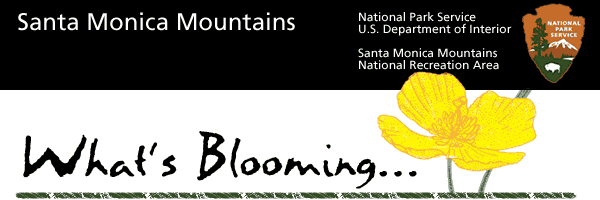
|
Available Sites |
|
Revised: 10/22/04 |
|
Circle X Ranch |
10/22/04 |
|
|
See the photo
gallery of What’s Blooming at: http://www.nps.gov/samo/bloom/bloom.htm |
||
|
The first rain of the year
has fallen in the Rec Area but it’s still too
soon to see much change. By this weekend many of the trails will have dried
enough to be free of the worst of the mud. The cool fall weather helps make
strenuous hiking more safe and enjoyable. |
||
|
Circle X Ranch |
Grotto Trail |
Date
Observed:10/22/04 |
|
The recent
rain and cooler weather has made everything feel fresh and clean. The sunny
sides of slopes are showing a multitude of tiny green plants that have
sprouted in the last few days. However, it seems even the summer bloomers are
running out now, many of which are down to a few isolated individuals still
blooming when most of their siblings have already gone to seed for the
season. In addition, many of the individuals still blooming are a bit faded
and/or wilted. At the top end of the trail you can still find Milk-asters
(both Tejon and Twiggy Wreath Plant) and the similar Cliff-Aster. The Woolly
Asters are looking a bit faded but are still easy to find. Only a few Sawtooth
Goldenbush are still blooming, most instead showing their brown
dandelion-like seed heads. The California Fuchsia is still plentiful adding a
striking red to the landscape. Down near the grotto we encounter California
Sagebrush and Wand Buckwheat. The tadpoles are at last gone but the pools of
the creek are all full again and the sound of water is everywhere. |
||
|
Naturalist's
rating: Poor |
||
|
Circle X Ranch |
Sandstone Peak Trail |
Date
Observed:10/13/04 |
|
It seems even the
summer bloomers are running out now, many of which are down to a few isolated
individuals still blooming when most of their siblings had already gone to
seed for the season. In addition, many of the individuals still blooming are
a bit faded and/or wilted This is a good time of year to see if you can
identify plants when in seed. Nevertheless, we saw a few saw examples of Bush
Senecio, Twiggy Wreath Plant, Tejon Milk Aster, Wooly Aster, Sawtooth Golden
Bush, and California Buckwheat. (TV) |
||
|
Naturalist's
rating: Poor |
||
|
Point Mugu State Park |
La Jolla Canyon Trail |
Date
Observed: 10/12/04
|
|
On 10/12/04 we hiked the La Jolla
Canyon Trail to the Large pond at the north end of the trail and returned via
one of the loop trails. The degree of the present drought was evidenced by
the total lack of water in the pond. Over the last 6 years I have never seen
this pond dry, but this year the cracked mud bottom was fully exposed. The
little pond and spring about 0.6 miles north of the trail head was also
completely dry, another first. Despite these outward signs of the drought a
surprising number of blooms were encountered along the trail, 23 different
species to be exact. This is more than were seen on hikes in July and August
this year. The yellow blooms were the dominant
group and included sawtooth goldenbush, telegraph weed, Calif. sage brush,
sweet fennel, tree tobacco, western goldenrod, hedge mustard, gum plant, and
ragweed. White flowers seen were morning glory, ashy-leaved buckwheat, coyote
bush, mule flat, cud weed, cliff aster and laurel sumac. Even reds were
represented with scarlet monkey flower, hoary fuchsia, and wand buckwheat
being spotted. Wooly aster, vervain, Calif. loosestrife and several bush
mallow represented the lavender/purple colors. The wildlife seen included brush
rabbits, groups of tits, and one granddaddy of a Calif. whiptail lizards that
must have been 16 to 18 inches long. I don't know where the wild life is
getting its water, but it seems to be plentiful with lots of deer tracks also
seen. (RWM) |
||
|
Naturalist's
rating: Fair |
||
|
Rancho Sierra Vista |
Native Plant Garden |
Date
Observed: 10/11/2004 |
|
Reliable water
brings out continual bloom here. You'll see both spring (fuchsia flowered
gooseberry, verbain, California wild rose, sticky
monkey flower, purple sage, bladderpod, yerba mansa) and summer blooms
(California fuchsia, conejo buckwheat, wand buckwheat) as well as dried
berries (rose hips) and pods (yerba mansa, narrow-leaved milkweed) (SB) |
||
|
Naturalist's
rating: Fair |
||
|
Paramount Ranch |
Coyote Canyon Trail |
Date
Observed: 10/11/2004 |
|
The hillside behind
the meadow and the Coyote Canyon Trail are covered with large yellow hawkfield tarweed flowers interspersed with blue flowers
of chicory. The trail has a very nice patch of vinegar weed. Also blooming
were coast goldenbush, bush mallow and ashy leaf buckwheat. (SB) |
||
|
Naturalist's
rating: Fair |
||
|
Rocky Oaks |
|
Date
Observed:9/08/04 |
|
Rocky is
another unit with a variety of habitats. The pond is a major feature because of
the persistent moisture. Consequently near the pond we see flowers not
present in some other locations or flowers that have elsewhere quit blooming.
In the low areas we can see Yellow Water Weed, stands of Water Smartweed,
Cattail, Wild Heliotrope, Lowland Cudweed, a few scattered Narrow-leaved
Milkweed, and some Purple Nightshade still in bloom. |
||
|
Naturalist's
rating: Fair |
||
|
Contact Information: Santa Monica Mountains National
Recreation Area 401 West Hillcrest Drive Ph. 805-370-2301 web. www.nps.gov/samo |
Thank you for your contributions: Robert W. Maughmer |
If you would like to contribute
to the wildflower report: e-mail: sheila_braden@nps.gov |
|
|
||